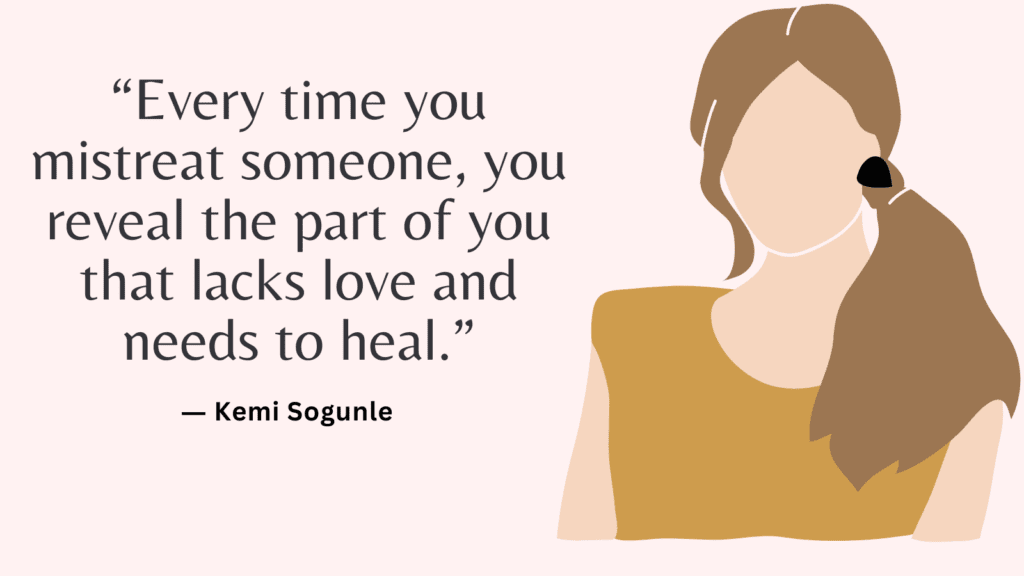This post contains 7 types of boundaries and how to establish them.
7 Types of Boundaries
Boundaries are essential in establishing and maintaining healthy relationships.
They serve as guidelines that define our personal limits, protect our well-being, and shape our interactions with others.
Understanding the different types of boundaries can empower individuals to establish healthier boundaries, communicate their needs effectively, and foster fulfilling relationships.
The following are the main 7 types of boundaries:
1. Emotional Boundaries
Emotional boundaries involve recognizing and respecting our own feelings and the feelings of others.
They help us differentiate between our emotions and those of others, ensuring that we do not take on responsibility for someone else’s feelings.
Establishing emotional boundaries grants us the space to prioritize our own emotional well-being without being overly affected by others’ emotional states.
Example:
- Letting a friend know that you are not comfortable discussing certain personal topics and would prefer to keep the conversation focused on other subjects.
- Expressing to your partner that you need some alone time to process your emotions before discussing a conflict or issue that arose between you.
2. Physical Boundaries
Physical boundaries pertain to personal space and touch.
Each person has unique comfort levels regarding physical contact, and it is crucial to communicate and respect these preferences.
Physical boundaries vary among individuals, cultures, and relationships.
They help foster a sense of safety, trust, and mutual respect.
Example:
- Politely declining hugs or physical contact from someone you are not comfortable with, even if they insist.
- Setting clear boundaries with a romantic partner regarding your physical comfort level, such as discussing what types of physical affection are acceptable to you.
3. Intellectual Boundaries
Intellectual boundaries encompass our thoughts, beliefs, and ideas.
It involves acknowledging and respecting differences in opinions, allowing for open and respectful dialogue.
Establishing intellectual boundaries enables individuals to engage in constructive discussions while avoiding intellectual domination or invalidation.
Example:
- Sharing your viewpoint during a discussion while still being open to hearing differing opinions, as well as respecting others’ perspectives without feeling compelled to change your own.
- Politely declining engaging in intellectual debates or conversations that you find draining or unproductive.
Related: Healthy Boundaries Quiz (+Free PDF Worksheets)
4. Time Boundaries
Time boundaries are about setting limits on how we spend our time and energy.
They involve prioritizing self-care, personal interests, and responsibilities.
By setting clear and realistic boundaries around our time commitments, we avoid overextending ourselves and create a healthy balance between our needs and the demands of others.
Example:
- Setting aside specific times each day for work or personal activities and communicating to family members or colleagues that during those times, you should not be disturbed unless it’s an emergency.
- Being assertive with friends or loved ones by letting them know when you need to prioritize self-care and take time for yourself, without feeling guilty about it.
5. Material Boundaries
Material boundaries involve defining our rights and limits regarding our possessions, finances, and resources.
Establishing and enforcing material boundaries ensures that our resources are respected and not taken advantage of.
By clearly communicating our expectations and limits around material possessions, we contribute to fair and meaningful exchanges within relationships.
Example:
- Establishing rules with roommates or family members about borrowing personal belongings and setting limits on how often you’re comfortable with them accessing your personal items.
- Saying “no” to lending money or possessions to someone if you feel uncomfortable or unsure about their ability to respect your boundaries.
Related: What Do Boundaries Sound Like? + 35 Boundaries Examples
6. Sexual Boundaries
Sexual boundaries relate to individual comfort levels, consent, and preferences regarding sexual activities.
It is crucial to have open and honest communication, establish clear boundaries, and respect each other’s autonomy and consent.
Enforcing sexual boundaries promotes healthy and consensual intimate relationships.
Example:
- Clearly communicating your limits and desires with your sexual partner(s), ensuring that consent and mutual understanding are established.
- Asserting your boundaries by saying “no” or stopping any sexual activity that makes you feel uncomfortable, even if you initially consented.
7. Digital Boundaries
In today’s digital age, it is essential to establish boundaries that govern our online presence and communication.
Digital boundaries involve setting limits around social media use, online sharing, and privacy.
By defining these boundaries, we protect our mental well-being, maintain healthy relationships, and ensure our online presence aligns with our values.
Example:
- Setting privacy settings on social media platforms and carefully selecting who can access your personal information or posts.
- Responding to incoming messages or emails when you are comfortable and available, rather than feeling obligated to reply immediately to every notification.
Related: +100 Examples of Boundary Violations & How to Deal With It
Top Misconceptions About Boundaries
Boundaries are an essential aspect of our psychological well-being and are crucial for maintaining healthy relationships and personal growth.
However, there are several misconceptions about boundaries that can hinder our understanding and implementation of them.
Misconception 1: Boundaries are selfish or rude.
On the contrary, boundaries are about self-care, self-respect, and maintaining one’s emotional and physical well-being.
By establishing boundaries, individuals communicate their needs, limitations, and values, which ultimately leads to healthier and more fulfilling relationships.
Misconception 2: Boundaries are meant to control others.
Boundaries are not about controlling others’ actions or behaviors; instead, they serve as guidelines for how we want to be treated and respected.
Boundaries focus on asserting our needs and preferences, rather than trying to change or influence others.
Misconception 3: Boundaries create distance and isolation.
Boundaries are not about shutting people out; they are about establishing a sense of safety, respect, and balance within relationships.
Healthy boundaries often enhance and deepen connections by fostering open and honest communication.
Related: Top 5 Tips On How To Be Assertive Without Being Rude
Misconception 4: Boundaries are fixed and unchanging.
In reality, boundaries should be flexible and adaptable.
As individuals grow and evolve, their needs and circumstances may change, necessitating adjustments to boundaries.
It is important to regularly reassess and communicate boundaries to ensure they align with personal growth and evolving dynamics.
Misconception 5: Boundaries are unnecessary in close relationships.
Some people believe that boundaries are only relevant in casual or professional relationships, assuming that close relationships do not require them.
However, boundaries are equally vital in intimate relationships, family dynamics, and friendships.
Respecting each other’s limits, emotions, and autonomy becomes even more critical in close bonds to foster healthy dynamics.
Misconception 6: Setting boundaries means saying “no” all the time.
While saying “no” when necessary is an important part of setting boundaries, it is equally crucial to identify and articulate what we do want.
Boundaries help us prioritize our time, energy, and emotions, allowing us to make intentional choices aligned with our values and goals.
Related: Boundaries Circle Worksheet (PDF Download)
Misconception 7: Boundaries lead to conflict and tension.
Healthy boundary-setting actually promotes clear communication and mutual respect.
It encourages open dialogue about individual needs and desires, which can enhance understanding and strengthen relationships.
FREE Boundaries Worksheet
How to Establish Healthy Boundaries?
Establishing healthy boundaries may seem challenging, especially when dealing with difficult people or situations.
However, by following these six steps, individuals can learn how to establish healthy boundaries effectively.
1. Identify Your Needs and Limits
The first step in establishing healthy boundaries is to identify your needs and limits.
Consider what makes you feel comfortable, what your values are, and what situations trigger your discomfort.
Take note of how your body and emotions respond in specific situations to recognize where your boundaries lie.
This will help you communicate your boundaries effectively and choose the appropriate response when someone oversteps them.
2. Communicate Assertively
Assertive communication is key to establishing healthy boundaries.
Use “I” statements to express your needs and expectations while avoiding blame or judgment.
Be clear and concise and avoid being apologetic or defensive.
For instance, instead of saying, “You always interrupt me when I’m speaking,” try saying, “I would appreciate it if I could finish my thoughts without interruption.”
This approach is non-confrontational yet assertive, helping you set a clear boundary while maintaining a respectful tone.
Related: Top 5 Tips On How To Be Assertive Without Being Rude
3. Avoid Over-Explaining
When setting boundaries, it’s important to avoid over-explaining or justifying yourself.
People who tend to over-explain often feel like they need to justify their boundaries to be taken seriously.
However, this type of behavior can be interpreted as a lack of confidence or insecurity.
It’s essential to communicate your boundaries with clarity and confidence without feeling the need to justify yourself.
Keep your message simple and straightforward.
4. Maintain Consistency
Maintaining consistency in enforcing your boundaries is crucial.
Consistency sends a message that your boundaries are non-negotiable.
If you allow others to cross your boundaries once or twice without consequence, it sends a signal that you are willing to tolerate behavior that makes you uncomfortable.
If someone repeatedly violates your boundaries, you may need to take more drastic measures to enforce them.
Be firm and consistent in your response to ensure others respect your boundaries.
5. Practice Self-Care
Self-care involves prioritizing your physical and emotional needs and taking steps to meet them.
Practicing self-care can help you maintain healthy boundaries.
Allocate time for activities that recharge you and set aside personal time regularly.
This can help you create a sense of balance in your life and avoid overextending yourself.
Furthermore, practicing self-care can boost your self-esteem and reinforce the importance of respecting your own needs and limits.
Related: Top 45 Self Care Day Ideas at Home To Kickstart Your Self Care Ritual
6. Seek Support
Establishing and enforcing boundaries can be challenging, especially when dealing with difficult people or situations.
Seeking support from trusted friends, family, or professionals can help you navigate these challenges.
They can provide feedback, insight, and guidance during challenging situations.
Furthermore, seeking support can validate your boundaries and provide a sense of community and connection.

Conclusion
In conclusion, establishing healthy boundaries involves identifying your needs and limits, communicating assertively, avoiding over-explaining, maintaining consistency, practicing self-care, and seeking support.
The process of establishing and enforcing boundaries may be challenging, but it is essential for maintaining your emotional and physical well-being.
Remember, setting healthy boundaries is not selfish; it is an act of self-care and self-respect that can improve your relationships and enhance your quality of life.



